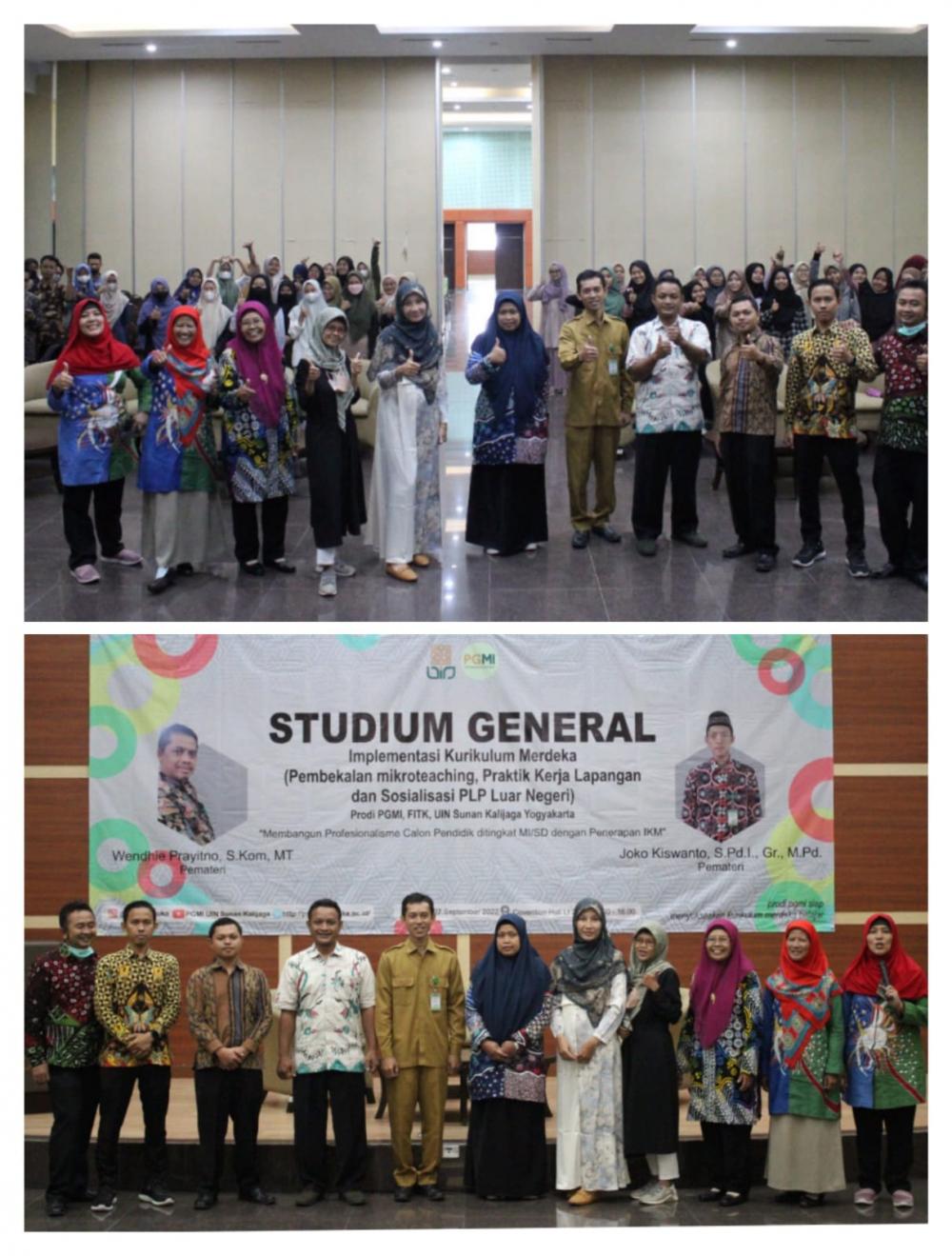Studium General "Implementation of the Merdeka's Curriculum" Education for Islamic Elementary School Teacher Program Sunan Kalijaga State Islamic University

On Monday, September 26, 2022, the State Islamic University of Sunan Kalijaga's Education for Islamic Elementary School Teacher Program held a General Study on the implementation of an independent curriculum with the theme "Building Professionalism of Prospective Educators at the Elementary Level with the Implementation of IKM." The event was held on the 2nd floor of the Sunan Kalijaga State Islamic University's Convention Hall. Education for Islamic Elementary School Teacher Program students, particularly the class of 2020, and several Education for Islamic Elementary School Teacher Program lecturers attended. The speaker of the stadium general is Mr Joko Kiswanto, S.Pd.I., Gr., M.Pd., who was an alumnus of the first batch of Education for Islamic Elementary School Teacher Program and the head of SD Muhammadiyah Al Mujahidin Gunung Kidul, which was the driving school for batch 1 in 2021. This Stadium general event was followed by Microteaching and Field Work Practices (PKL) briefing for 2020 students.
Mr Joko Kiswanto presented many opinions on implementing Merdeka's curriculum. First and foremost, he explained the definition of "independence," essentially freedom; the goal of Merdeka's curriculum is that an educational curriculum system should not be inflexible, restricted, boring, and less in favour of each student's demands. The curriculum should be a "servant to students," which means that all resources, efforts, and costs mobilized for learning implementation must fit the requirements and characteristics of each student individually. Each student has unique conditions, traits, and needs; therefore, learning implementation must meet each student's demands. It impacts students' learning models, material, and practice. Based on this, before learning begins in the Merdeka curriculum, an initial assessment (diagnostic) is implemented using a SWOT analysis; this is important to evaluate the student's starting condition, characteristics and needs that he needs to learn. Following the initial assessment findings and the use of differentiated learning, it is required to classify students based on their capabilities, conditions, and characteristics based on the initial/diagnostic assessment results. This differentiation system, which is roughly split into several such differentiation groups, must identify what therapy or treatments the teacher should apply to facilitate each student's learning. This aspect of differentiation includes processes, learning styles, products, and learning content.
In this Merdeka's curriculum system, the lower and upper classes have been replaced with the term phase, and this phase is used to determine learning outcomes based on the characteristics of the learning development of each of these phases. There are six levels of learning success in primary and secondary education: elementary, junior high, high school, and vocational school. At the primary level, there are three levels of learning achievement: phase A (grades I-II), phase B (grades III-IV), and phase C (grades V-VI) (grades V-VI). Each phase supports a student in trying to master the results of their learning to reach the learning objectives of each desired learning achievement. As a result, while conducting a learning evaluation, if a student has not mastered the desired competence, remedial activity is taken until the student can master the expected competence. Consequently, students are not left behind and may maximize the process and outcomes expected from each stage of learning achievement.
He also presented an example of the application of Merdeka's Curriculum at the school where he worked, SD Muhammadiyah Al Mujahidin Gunung Kidul, the driving school for the batch I in 2021. Some of them are autonomous curriculum learning using a subject approach; the curriculum employed is the 2013 Curriculum in grades 3 and 6 and Merdeka's Curriculum in grades 1, 2, 4, 5, and 6. Then the assessment used is the initial assessment, formative assessment, final theme/topic summative assessment (ASAT), end-of-semester summative assessment (ASAS), and end-of-phase summative assessment (ASAF). SD Muhammadiyah Al Mujahidin uses the Daily Feeling Chart model for the initial assessment, in which students are asked to choose facial expressions (emoticons) that have been provided in front of the class. Emoticons describe their heart condition on that day so that the teacher can ensure readiness to learn by looking at each student's heart condition or mood before learning begins. When students select emoticons with gloomy, angry, or unhappy expressions, the teacher can teach them to be cheerful, joyful, happy, and eager to learn in class.
Mr Joko Kiswanto presented information on the autonomous curriculum, and the program continued with a question-and-answer session with students who were already there. Many students expressed their concerns about implementing Merdeka's curriculum from diverse perspectives. The lecturers who attended the session were equally excited and asked some interesting questions. The stadium general session was then followed by microteaching and Field Work Practice (PKL) debriefing for class 2020 students. The entire set of activities was designed to prepare prospective students of professional educators to constantly improve and update themselves to grasp and learn about various difficulties in the field of education. Especially important is basic education.
